Patient Experience vs. Patient Satisfaction: Why the Difference Matters in Healthcare

Patient Experience vs. Patient Satisfaction: Why the Difference Matters in Healthcare
In healthcare, “patient experience” and “patient satisfaction” are often used interchangeably — but they’re not the same. Understanding the distinction is crucial for any practice seeking to enhance the quality of care, patient loyalty, and overall brand reputation.
Defining Patient Experience
Patient experience refers to what actually happens during a patient’s interactions with your practice — every touchpoint from scheduling to follow-up. It’s measured by whether the processes, communication, and environment align with best practices and patient needs.
At Healthcare Management Consulting Group (HMCG), we describe patient experience as the sum of Nine Patient TouchPoints — from the first impression on your website to the patient’s long-term relationship with the practice. Each moment contributes to how patients perceive your organization’s empathy, efficiency, and professionalism.
Patient experience answers questions like:
- Was it easy to schedule an appointment?
- Did staff communicate clearly and respectfully?
- Did the provider explain the diagnosis and treatment plan?
- Was the follow-up timely and compassionate?
These are objective, actionable data points — they highlight where systems, staff behaviors, or workflows need improvement.
Defining Patient Satisfaction
Patient satisfaction, on the other hand, reflects how patients feel about their experience. It’s subjective and influenced by personal expectations, emotions, and preferences.
Two patients may receive identical care, yet one feels highly satisfied while the other doesn’t, not because of clinical quality, but because of expectations.
Patient satisfaction answers questions like:
- Did the visit meet or exceed your expectations?
- Were you happy with the wait time?
- Would you recommend this provider to others?
Satisfaction scores are valuable, but they don’t always tell the whole story. A patient may be “satisfied” because their favorite staff member was friendly, even if the process itself was inefficient or unclear.
How They Work Together
- Patient experience identifies what happened.
- Patient satisfaction reveals how it felt.
When combined, they create a 360° view of how your practice performs, both operationally and emotionally. Practices that track both are better equipped to implement meaningful improvements, not just cosmetic fixes.
For example:
- Experience data might show long call wait times.
- Satisfaction data might show frustration with communication.
Together, they highlight a clear operational opportunity: enhancing phone workflows and communication protocols.
Why It Matters for Healthcare Practices
Focusing only on satisfaction can lead practices to chase “smiles over systems.” True operational excellence comes from improving the experience — the consistent, measurable moments that define quality care.
By designing workflows around the patient experience, practices naturally elevate satisfaction, retention, and revenue.
HMCG’s Perspective
At HMCG, we help healthcare organizations bridge this gap. Our Nine Patient TouchPoints framework maps the entire patient journey to identify what’s working, what’s not, and where training, process redesign, or communication strategies can elevate both experience and satisfaction.
Because in the end, satisfied patients tell others about your practice.
But positive patient experiences keep them coming back.
Read our other Insights about Patient Experience.
